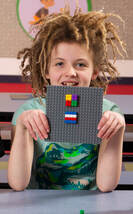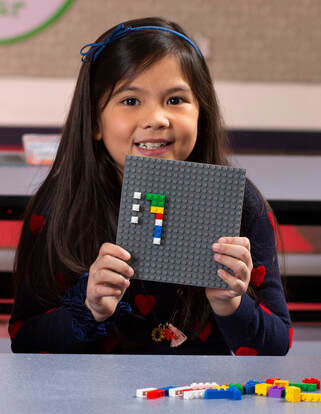 It’s easy to adapt a program used in schools to create a homeschool curriculum that works well for your kids. Here are five tips for teaching a new curriculum when you're starting to homeschool. 1. Watch an expert to see how the program is taught. Now that you’re the teacher, it will really help to learn the important terms to include and see the lesson in action. Brick Math has lots of video lessons for you and your child to watch, all taught by the author of the program, Dr. Shirley Disseler (aka “Dr. D”). 2. Read through the whole lesson before you start teaching it. (This is the same advice that cookbook authors give about reading through the whole recipe before you start cooking!) It’s critical that YOU understand what you’re teaching before you start. With math, that’s key. Most of us learned math in a very different way than we would teach it today. Make sure the whole lesson “makes sense” to you before you begin working with your child. Each Brick Math lesson is step-by-step, so as you read it, you can feel comfortable with each step along the way.  3. Gather all the materials you need for the lesson before you start. You don’t want to lose momentum by having to stop and search for pencils, paper, or manipulatives. When you and your kids are ready to learn, you want to take full advantage of the time you have! At the beginning of each chapter in every Brick Math book there is a list of the LEGO bricks and baseplate needed to teach the lessons in that chapter, so make sure you have those, either from your personal stash of LEGO bricks, or from the Brick Math brick set. Your student will draw models and answer questions in the student books. All you need to add are pencils or markers, and you’re ready to go. 4. Take as much time as your child needs to complete a lesson. One of the best features of homeschooling is that kids work at their own pace, not at the pace of a whole class full of students. Check as you go along to be sure that your child really understands the material every step of the way. The Brick Math program includes regular check-ins with the student, and assessments for each chapter that give you confidence that your child has learned the math.  5. Make it fun! Many homeschooling parents are proud to talk about how much their children enjoy learning through the creativity of their programs. And what’s a more fun way to learn math than building with LEGO bricks? Students everywhere tell us how much fun they have learning math this way. Teachers have told us that sometimes their students ask to “keep doing Brick Math” rather than have recess! Brick Math is a K-6 math curriculum that works for all students, whether they are in a classroom or learning at home one-on-one. If you have a student at home who is learning math, check brickmath.com. The website includes videos for both teacher/parent training and direct instruction of students. You can learn more about how Brick Math improves student math test scores and hear what people who are using Brick Math have to say about the program. Brick Math is a K-6 math curriculum that uses LEGO® bricks to model 11 different math subjects: Counting, Addition, Subtraction, Multiplication, Division, Basic Fractions, Basic Measurement, Fraction Multiplication, Fraction Division, Advanced Measurement and Geometry, and Decimals. It works well for math intervention, for enrichment, and as a whole-school program. Materials are simple and need not be shared between students. It adapts easily to online instruction. Contact us with any questions.
0 Comments
 I recently had a customer tell me that her son didn’t understand the idea of factors until she tried Brick Math. When he saw the concept of factors made real with LEGO bricks, she said, he knew what they were! It’s exciting to hear when students finally “get it” because modeling with bricks makes all the difference for them. I started to think about that lesson on factors, and I realized it is the perfect way to demonstrate the power of Brick Math as a learning system. Here’s why Brick Math works so well to teach elementary math: it’s tactile (kids touch the bricks and build the models themselves), it’s visual (kids can see exactly what the numbers in a math problem represent), and it’s conceptual (kids understand the underlying idea behind the math when they discover it for themselves in a guided program). Let me show you how Brick Math works with that lesson on factors: This lesson models all the factors of 16 and demonstrates perfectly the meaning of “factor." Like all Brick Math lessons, it starts with some basic bricks and a baseplate to build on. Begin by placing one brick that has 16 studs on the baseplate (studs are the bumps on LEGO bricks). This can be a 2x8 brick or a 1x16 brick.The model shows 1 brick with 16 studs, so the multiplication fact shown is 1 x 16 = 16. 16 and 1 are factors of 16.  Next, take two bricks that each have 8 studs and place them next to the brick that’s already on the baseplate. It’s best if those two bricks are two different colors. You’ll use either two 2x4 bricks or two 1x8 bricks. Now the model shows 2 (bricks) x 8 (studs) = 16, and that 2 and 8 are also factors of 16. Now, here’s where the Brick Math program really becomes a powerful learning tool. For the next step, ask the student, “Are there 3 bricks that are all the same size that you can use to build the next row?” Let your students try with different bricks. They will demonstrate to themselves that there are none, so 3 can’t be a factor of 16. It’s so important that students discover for themselves while they are learning. That’s what helps them internalize what the math is all about. When they move on to looking for 4 bricks, they’ll find that four 2x2 bricks or 1x4 bricks do the trick. Now, they have 4 (bricks) x 4 (studs) = 16, so 4 is another factor of 16.  Have them look again for 5, 6, and 7 bricks that work in the model. They’ll quickly figure out that none of those numbers are factors of 16. They’ll move on to modeling eight 1x2 bricks, with the multiplication fact of 8 x 2 = 16. Finally, they can add sixteen 1x1 bricks to the model to complete all the factors with the multiplication fact of 16 x 1 = 16. When you look at the final model and count the number of bricks, the final model clearly shows the factors of 16: 1, 2, 4, 8, and 16. Dr. Shirley Disseler, developer of the Brick Math method, demonstrates this same lesson in the video below.  The concept of factors is key to learning multiplication, division, and fractions, so it’s in all three of the Brick Math books on those subjects: Multiplication, Division, and Basic Fractions. And it (almost) goes without saying: students have fun while they learn! If you teach math or have a student at home who is learning math, check brickmath.com. The website includes videos for both teacher training and direct instruction of students. You can learn more about how Brick Math improves student math test scores and hear what people who are using Brick Math have to say about the program.
Brick Math is a K-6 math curriculum that uses LEGO® bricks to model 11 different math subjects: Counting, Addition, Subtraction, Multiplication, Division, Basic Fractions, Basic Measurement, Fraction Multiplication, Fraction Division, Advanced Measurement and Geometry, and Decimals. It works well for math intervention, for enrichment, and as a whole-school program. Materials are simple and need not be shared between students. It adapts easily to online instruction. Contact us with any questions.  Whether you're back to school in person or online, or some combination of the two, this free Brick Math Lesson of the Month is a great way to help students learn math. For September, it's a lesson from Fraction Multiplication Using LEGO® Bricks that shows how the commutative property works when multiplying fractions. Students typically learn about multiplying fractions in grades 4 - 6, but it is sometimes part of the curriculum when students are learning about fractions in grades 2 - 3. To get the free Lesson of the Month for September 2020, click here. Students should already understand that a x b = b x a (see Multiplication Using LEGO® Bricks, chapter 5). Now it's time for them to learn that the same commutative property holds when multiplying fractions. This lesson makes it clear to students by using bricks one way to model 1/2 x 6, and a different way to model 6 x 1/2. In both cases, the answer, 3, is the same.  This lesson also shows how the two number sentences are used to describe different real-life situations: 1/2 x 6 means "one-half of six," while 6 x 1/2 means "six sets of one-half." So in real-life usage, 1/2 x 6 could describe "half of the six crayons in the box, or three crayons." And 6 x 1/2 could describe "six half-pizzas, or three whole pizzas." Using bricks to model these two scenarios really helps students understand the math.  Brick Math is a K-6 math curriculum that uses LEGO® bricks to model 11 different math subjects: Counting, Addition, Subtraction, Multiplication, Division, Basic Fractions, Basic Measurement, Fraction Multiplication, Fraction Division, Advanced Measurement and Geometry, and Decimals. It works well for math intervention, for enrichment, and as a whole-school program. Materials are simple and are not shared between students. It adapts easily to online instruction. If you teach math or have a student at home who is learning math, check brickmath.com. The website includes videos for both teacher training and direct instruction of students. You can learn more about how Brick Math improves student math test scores and hear what people who are using Brick Math have to say about the program. |
Categories
All
Archives
July 2024
|


